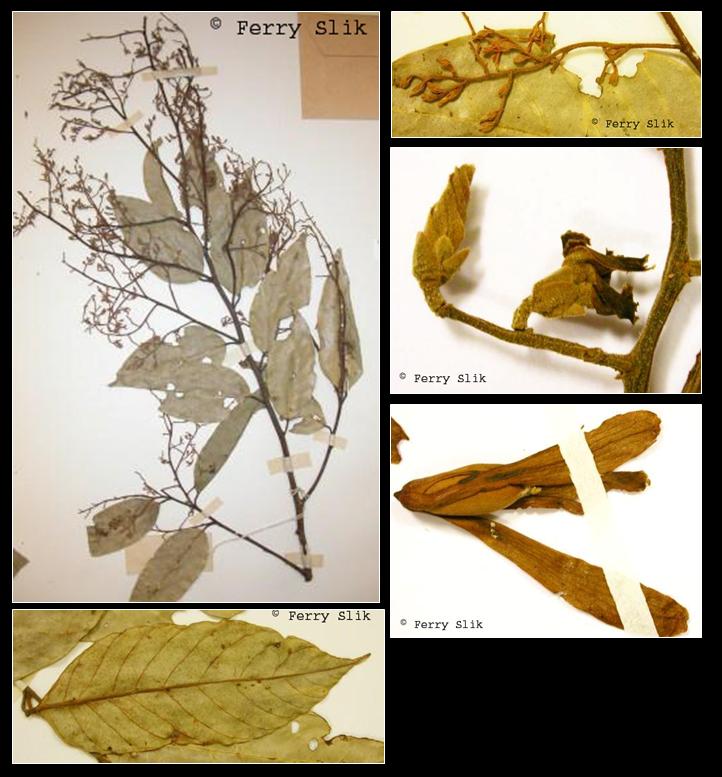Shorea gibbosa Brandis, J. Linn. Soc. Bot. 31 (1895)
Latin for 'humped'.Synonyms
Hopea grisea Brandis
Diagnostics
Emergent tree up to 58 m tall and 110 cm dbh. Stem with resin. Stipules up
to ca. 3 mm long. Leaves alternate, simple, penni-veined, glabrous. Flowers ca.
11 mm in diameter, white-red, placed in panicles. Fruits ca. 16 mm long,
green-red-brown, with three ca. 49 mm long wings, wind dispersed.
Description
Very tall, buttressed tree. Twig, bud, petiole and
stipule persistently shortly evenly pale rufous pubescent,
leaf nervation beneath sparsely so, glabrescent.
Twig c. 1 mm apically, slender, much branched, at
first frequently rugulose. Stipules to 3 by 1 mm,
narrow ly elliptic, acute, fugaceous. Leaves pink when
opening, 5-13 by 2-6 cm, ovate, chartaceous, undulate;
base broadly cuneate to obtuse; acumen to 1.5 cm
long; nerves 7-9 pairs, slender but prominent beneath,
at 50-65 degrees; tertiary nerves subreticulate; midrib somewhat
depressed above, prominent beneath; petiole
8-12(-16) mm long, short. Panicle to 10 cm long,
terminal or axillary, terete, densely persistently buff to
pale rufous pubescent; singly branched, branchlets to
2 cm long, bearing to 6+ distichous flowers;
bracteoles to 2 by 1 mm, oblong, obtuse, shortly
pubescent, fugaceous. Bud to 5 by 3 mm, lanceolate.
Sepals ovate, shortly densely pubescent on parts
exposed in bud; outer 3 acute, inner 2 shortly
acuminate, relatively broader, shorter, thinner at the
margin. Petals cream with a pink base, narrowly
oblong, strongly contorted, sericeous on parts
exposed in bud. Stamens 15, in 3 unequal verticils, the
longest reaching the style apex; filaments compressed
and gibbous at base, tapering and filiform below the
small broadly ellipsoid anthers; appendage to connective
somewhat longer than anther, slender, glabrous.
Ovary ovoid, densely pubescent; style columnar,
pubescent in the basal 4, otherwise glabrous. Fruit
pedicel to 2 mm long, slender. Calyx shortly sparsely
pubescent; 3 longer lobes to 9 by 2 cm, spatulate,
obtuse, c. 4 mm broad above the to 10 by 6 mm ovate
saccate thickened tuberculate base; 2 shorter lobes to
6 by 0.5 cm, narrowly spatulate, acute, similar at base.
Nut to 1.8 by 1.2 cm, narrowly ellipsoid, densely buff
pubescent, acute. [from Flora Malesiana]
Ecology
In undisturbed mixed dipterocarp forests up to 800 m altitude. On alluvial
to dry sites, usually on clay soils. Locally common on deep fertile clay-rich
soils, on undulating land and low hills.
Uses
The timber is used.
Distribution
Peninsular Malaysia, Sumatra, Borneo.
Local names in Borneo
Borneo: Awang pakit, Damar tenkuyung, Damar ketuyung, Gimma, Kenuar, kelepeh, Ladan,
Lempong kuning, Lun, Lun gajah, Lun kuning, Madilan, Merakunyit, Meranti kuning,
Selangan batu, Seraya kuning, Seraya kuning gajah.
